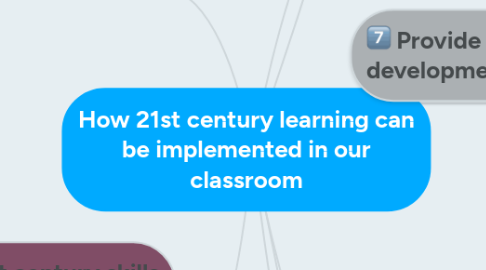
1. Create 21st century standards
1.1. Emphasize on the 21st century skills among student
2. Incorporate 21st century interdisciplinary themes into key subjects
2.1. Global awareness
2.1.1. Address global issues in class
2.2. Financial, economic, business and entrepreneurial literacy
2.2.1. Conduct school book fairs and encourage students' participations
2.3. Civic literacy
2.3.1. Take students to visit government buildings
2.4. Health literacy
2.4.1. Promote physical activities among students during physical education lessons
2.5. Environmental literacy
2.5.1. Bring students out from the classroom to appreciate mother nature
3. Focus on key subjects
3.1. English
3.2. World languages
3.3. Arts
3.4. Mathematics
3.5. Economics
3.6. Science
3.7. Geography
3.8. History
3.9. Government and civics
4. Integrating 21st century skills into classroom learning activities
4.1. Learning and innovation skills - 4Cs
4.1.1. Creativity
4.1.1.1. Encourage students to brainstorm ideas
4.1.2. Critical thinking
4.1.2.1. Ask students to solve real-life problems
4.1.3. Communication
4.1.3.1. Constantly ask students to speak up for ideas
4.1.4. Collaboration
4.1.4.1. Design group work for students
4.2. Information, media and technology skills
4.2.1. Information literacy
4.2.1.1. Encourage students to search information online
4.2.2. Media literacy
4.2.2.1. Utilize media creation tools
4.2.3. Information, communications and technology literacy
4.2.3.1. Use technologies such as computers, tablets, media players and projectors in class
4.3. Life and career skills
4.3.1. Flexibility and adaptability
4.3.1.1. Provide students with various roles, tasks responsibilities, schedules and work
4.3.2. Initiative and self-direction
4.3.2.1. Give students guidelines to work on instead of giving specific instructions
4.3.3. Social and cross-cultural skills
4.3.3.1. Arrange students to work in a diverse team breaking across social and cultural differences
4.3.4. Productivity and accountability
4.3.4.1. Assess students work
4.3.5. Leadership and responsibility
4.3.5.1. Conduct leadership seminars
5. Create 21st century learning environment
5.1. Create learning practices, human support and physical environments that support the 21st century skill outcomes
5.2. Allow student to learn in real-world context
5.3. Encourage the use of learning tools, technologies and resources
5.4. Support students in learning both physically and virtually
6. Provide students with 21st century professional development
6.1. Implement project-oriented teaching methods
6.2. Model the kinds of classroom learning that promotes 21st century skills
6.3. Identify students’ learning styles, intelligence, strengths and weaknesses
6.4. Adjust different types of teaching methods accordingly
6.5. Encourage knowledge sharing among students with the professionals
6.5.1. Invite the professionals to conduct workshops in schools
7. Implement 21st century curriculum and instruction
7.1. Teach 21st century skills in the context of key subjects along with 21st century interdisciplinary themes
7.2. Provide students with opportunities for applying 21st century skills
7.3. Implement innovative learning methods that integrate the use of technologies
7.3.1. Inquiry-based learning
7.3.2. Problem-based learning
7.3.3. Higher order thinking skills
